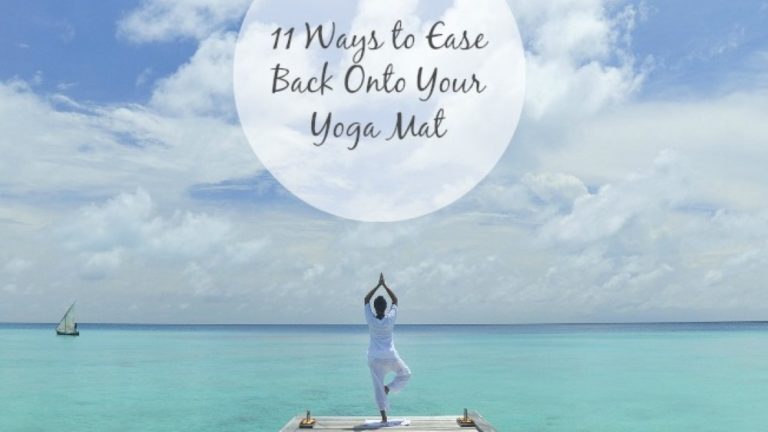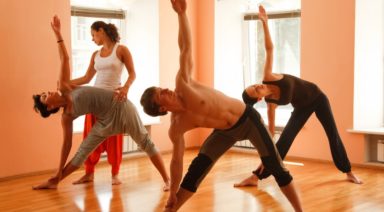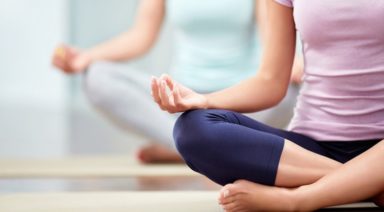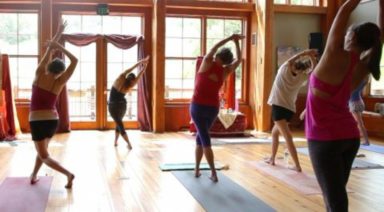11 ways to get get back into the yoga swing of things

So you’ve been wanting to try our Breakfast of Champions Challenge, but don’t know where or how to start. Maybe it’s been too long since you last dug out your mat. Maybe you had an injury and had to abstain for a bit. Maybe you’ve just been watching TV all day instead of getting up and at ‘em! Whatever your reason is, Tommy Rosen’s energizing and revitalizing video is only 20 minutes, and an amazing start to your day! But if you want to take it a step further and get back into your regular daily yoga schedule, Yoga Journal has some tips this past issue on how to do it (we threw in our GTV take, as well!):
- Accept where you are: after a long hiatus, your practice won’t be exactly the same. And that’s totally okay! The key is knowing that yourself, and making peace with it. Then get up and keep going!
- Take the long view: take a look at where you want to be and know that wherever you are now, if you are consistent, you will get there. Vinyasa and therapeutic yoga teacher Tiffany Cruikshank describes it as, “You’re starting a new relationship with your yoga practice and, in some ways, your body is totally foreign to you. You have to think of where you will be six months from now as opposed to just killing yourself and giving up.”
- No practice is too short: every minute counts! Even if you start with only a quick 5 minute series of poses, it’s still more than you did yesterday. Aim to increase it by a minute or two every day, or get in multiple sets of five minutes. It’s great to just get the discipline in of starting.
- Dedicate a space: half the battle is getting the mat out, are we right? So leave it out and ready to go. It doesn’t have to be a big space, but just in an accessible place you won’t overlook, along with all the gear you’ll need.
- Don’t overdo: it’s okay to literally ease into it. Yoga Journal suggests working 50-75% of what your old “normal” used to be, and to take it easy on the advanced poses, as your body may have lost flexibility and strength. Nothing like another injury to put the brakes on your restarted practice!
- Start fresh: maybe your last practice was part of why you stopped. You can try new classes, teachers, and forms of yoga to keep it new and non-routine. Let yourself feel like a beginner again, and you can see things from a new perspective and with a new voice.
- Take a private class: scared to be a beginner again? A private instructor may have the one-on-one patience you need to be encouraged to continue. It can be just for a few sessions, as well; whatever you need to get back in the groove and gain your confidence.
- Find a challenge: when you’re doing a challenge that has a set goal, schedule, and finite amount of time, it can be easier to achieve than simply reaching for the nebulous “Get back into yoga!” goal. Luckily, we’ve made it easy for you to start, and we also have a great community of fellow yogis that would love to keep you accountable!
- Indulge in the poses you love: positive reinforcement is a great way to motivate yourself. If you drag your feet to your yoga mat, reignite the fire! Find the passion again with the poses you enjoy! You’ll be looking forward to your next yoga-you-time before you know it.
- Try the ones you don’t love: giving yourself a goal to reach for can also be a great motivator. “Hard poses never get stale,” after all. Whatever you try, give it your best shot; no slacking!
- Deepen your connection to yourself: yoga is an extremely personal, intimate practice. Yoga Journal reminds us, “Remember that first and foremost yoga is a path toward quieting your mind.” The keys to a successful, fulfilling yoga practice is loving yourself, and aware of what’s going on internally. Don’t tune out your inner voices, and you are sure to have a great time. We hope these tips help you on your yoga journey. Now switch off the computer and hop on your mat! Namaste.
What is Tantra Yoga?

If the word Tantra conjures up scenes of sexuality, you’re not alone. The introduction of Tantric practices in the West has inadvertently become identified with a practice that’s laced with nudity, sexuality, and occasionally, promiscuity.
The truth is, Tantra may enhance your sex life, but only by deepening your connection to your energy and your body first. Although Tantric practices are founded on the principle of intimacy, intimacy is not purely physical. It’s the act of connecting so deeply that you feel as if you are getting a glimpse into your and perhaps another’s soul.
I’ve heard it described as “into me I see” based on the premise that we must gain an awareness of our true selves before we can forge the path of union with others.
What’s the point of Tantra Yoga?
The purpose of Tantra Yoga, is to further emotional wellbeing, aiding spiritual and physical health.
The exploration of the subtle energies within the body and their connection to the universe provide the opportunity to understand the purpose of life and the principles of union in new dimensions.
Rod Stryker, a prominent teacher of Tantra Yoga, describes the intention of Tantra Yoga, “(it) shows us what is blocking us from thriving and offers techniques that will help us attain spiritual and material prosperity.” Hence the goals of the Tantric practices are to enable us to prosper, to thrive and to merge the spiritual world and the material world into one.
What is Tantra Yoga?
The word Tantra means, “to weave or expand.” The root of the word yoga is “yuj” which means, “union.” Similar to some of the other 8 Forms of Yoga, Tantra Yoga blends elements of Raja, Bhakti, Karma, Kundalini, and Hatha practices. What distinguishes it from others is that it also weaves dynamics of other mystical practices as well such as: astrology, Ayurveda, crystals, and gemology to name a few. In utilizing these aspects, the Tantric practice aims to expand beyond perceived limitations of yogic philosophy and the asanas.
The comprehensive approach of Tantra Yoga incorporates conscious breathing practices, pranayama, and meditation, and may be practiced individually or in partnership with another. In both practices, the relationship between the micro (self) and the macro (others) is enhanced.
Vinyasa, as a moving meditation through postures, or asanas, also may be practiced partnering, as a blending of energies or as a sole practitioner. The aim is the same: to gain awareness of our strengths and weaknesses, the places where we resist union with ourselves and others, and cultivate the ability to consciously respond rather than unconsciously react to both our fears and desires. When that occurs, we reach a state of eternal bliss.
Five Tantra Yoga Practices
1. Peace Pose with Pranayam, Conscious Breathing
Begin in a cross-legged seated position, Sukhasana, or peace pose. Gaze down; if knees are higher than hip creases, sit on a yoga block or rolled up yoga mat to elevate the spine.
For solo practice, place hands in gyan mudra (also referred to as jnana mudra in some practices) with the tip of the index finger touching the tip of the thumb, extending out the other three fingers with the palms facing up and resting on knees or thighs. Gyan mudra, a yogic shape for the hands, is considered the prime mudra with many health and grounding benefits.
If practicing with a partner, sit back to back in peace pose, sukhasana. You’ll want to align your spines: start by scooting your seats as close to one another as possible. Option to use prithvi mudra, tips of the ring fingers touching the tips of the thumbs, remaining three fingers outstretched but relaxed. This mudra creates a circuitry igniting the heart meridian, or line of energy that extends from the ring fingers, extends up through the arms and confluences at heart center in both the front and backside of the chest.
Take five full breaths, focusing on smoothing out the length of the inhale to match the same length on the exhale.
2. Sun Salutations, Surya Namaskar
Start in mountain pose (tadasana/urdhva hastasana), standing at the top of your yoga mat. As an individual practice, you may like to practice facing a full-length mirror. In a partner practice, you could either practice facing one another or side by side. Bring palms to meet at heart center in anjali mudra (prayer gesture) or place one hand on your heart, and one on your partner’s heart. Take five deep breaths.
Extend arms overhead, mountain pose, then bow forward, keeping your heart open and gaze forward, and release your head into a forward fold (uttanasana). Bring hands to shins or thighs and lengthen through your spine for a halfway lift (ardha uttanasana). Repeat three times.
3. Modified Side Plank/ Partner Modified Side Plank Pose
Start in table pose, wrists aligned under shoulders, hands spread wide, and hips stacked over knees. For partner modified plank pose, you can lightly touch the crown of the head with one another while in table. Then extend your right shins behind you, toes curled under as you root right hand into the mat and open your chests towards one another.
For an individual practice, bring your left hand to rest over your heart as you stack your left shoulder over right so your heart is wide open. Your hips are also stacked creating a beautiful opening for what are considered our more vulnerable energetic centers: hips and hearts. In partner practice, connect left palms overhead. Enjoy five breaths. Return to table and then switch sides.
4. Partner Peace Pose, Entwined Sukhasana
Come into a loose, cross-legged position (typically the larger person in sukhasana first). Your partner then sits on your thighs and crosses their ankles behind your back. Touch your third eye centers (space between the eyebrows) as you both lengthen through your spines. You may choose to close your eyes or gaze lightly into each other’s eyes as you inhale and exhale through the nose. Take five breaths, allowing a natural synchronicity of breath, with your palms resting on the backside of your partner’s heart. Surrender to the intimate experience of both your and your partner’s heartbeat.
5. Child’s Pose (Balasana), Partner Child’s Pose
Bring your knees wide to the edges of your mat, fold forward resting your forehead on the mat, arms extended overhead but resting on the mat. (If knees are sensitive, you can place the folded edges of a blanket behind your knees before folding forward or rest your seat and perhaps forehead on yoga blocks.) If shoulders allow, bring your palms to touch in prayer, symbolic of union with all aspects of yourself.
For partner child’s pose, assume the same shape described above, with heads pointed towards one another. With arms outstretched, you can place your left palm down, and your palm up to connect with your partner’s palms. It’s said that our hands are an extension of our hearts. Envision your inhale emerging from your left palm, breathing in the essence of your partner, and exhaling through your right palm, sharing your essence with your partner.
For a more advanced practice, presuming both partners have healthy knees and spines, you may like to have one partner (typically the larger partner) stay in child’s pose, and the other, sit facing the opposite direction, on the low back of the partner in child’s pose. Slowly, keeping weight in your feet, begin to lower down, using the support of hands on the mat alongside the bottom partner’s hips. Eventually, lower your spine to align with the partner in child’s pose, and relax arms alongside, or extend your arms overhead, sliding palms underneath your partner’s palms.
Stay in close communication with your partner in child’s pose to ensure that each of the actions feels safe and available in their body.
Expand Your Capacity For Intimacy
If you’re practicing Tantra Yoga on your own or with a partner, you’re expanding your capacity for intimacy and union. With practice, we’re able to get up close and intimate with the beliefs and behaviors that hold us back from the intimacy we desire. In addition, Tantric techniques are provided to evolve beyond these barriers so that each and every one of us may thrive and prosper.





































